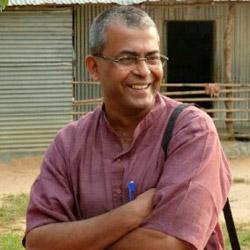I came to the Northeast for the first time in 1975 as a young student from Kerala. Since then, I have travelled in Assam, Manipur, Meghalaya, Mizoram, Nagaland, and Tripura as part of church groups, nonprofits, and educational institutions. In 2008, I became the director at Bosco Institute in Jorhat, Assam, which offers a Master’s in Social Work programme, helps nonprofits in project implementation, and runs an incubation programme that supports young social entrepreneurs in the Northeast through incubation, initial funding, capacity building, organisational development, etc.
In all these years of working closely with young people in the region, I have learned that they are articulate and aspirational, but also lonely as they lack support from the family and community in pursuing unconventional professions such as working in the social sector or becoming an entrepreneur. They have dreams of changing the society for good, but are often held back by a dearth of know-how, funds, and proper mentoring. The communities also suffer from the social sector’s poor understanding of their cultures, geographies, and sociopolitical conditions.
Here are some learnings that I would like to share with the ecosystem of funders, nonprofits, and aspiring nonprofit leaders on working in the Northeast. I believe these lessons can be a starting point for anyone wanting to meaningfully engage with these states.
1. The Northeast is not homogenous
The social sector has grown rapidly in the Northeast in the past few decades, but this growth has not always been beneficial for community members. While big funders and nonprofits started working in the area, they did so without really understanding the complexity of the geography, politics, and culture of the eight states that form the region. This led to them replicating their pan-India programmes in the Northeast without customising it to the context of the place.
For example, many assume that Nagaland has a singular Naga identity, not realising that there are multiple communities and clans within it. They have their own distinct languages/dialects and cultures and, thus, their challenges differ even from one another. A homogenous solution won’t serve them all. Communities in the Northeast are divided by geographies—people live in the plains, hills, and riverine areas, and have their unique resources and problems. Can a nonprofit that doesn’t understand this diversity ever actually help the communities?
There’s a tendency in the social sector to chase numbers because the funders demand it. Nonprofits start working in a village with a select group of people (such as in the self-help group model), run their programme, measure impact, and move on to the next village. However, evidence shows that these groups often exclude people from marginalised sections. The secret to a more inclusive social development model might lie in thinking at a smaller scale. Instead of covering 30 villages in a state within a short time span, nonprofits could work with one village or a cluster of villages with all the community members in that area, until the community is empowered to self-sustain the change.
In fact, in Sonapur area in Assam’s Kamrup Metropolitan district, Bosco Institute has partnered with Spread NE, a nonprofit that works on farming and farm-based entrepreneurship. Every household—young people, women, and children—is part of this project on natural farming. Depending on which aspect of agricultural enterprise they are interested in, the community members are involved in production, marketing, and networking. People work at their own pace without the stress of meeting targets within a limited time frame. Since they have adopted the project as their own, they have come up with additional business ideas such as creating a tourism trail so that tourists can stay at the farms, earning them an extra income.

2. Funders should invest in ideas and allow failures
These states have gone through years of political unrest, which has had an impact on the people’s mental health and social well-being. There is a scarcity of resources that prevents them from taking up professions such as entrepreneurship and social work, which are considered risky. They are encouraged to pursue government jobs or become doctors or engineers, because these are thought of as stable career options.
When young people choose to work in the social sector, they do so by going against the tide. Many of them start an initiative, but are forced to give it up due to family and social pressure and financial stress. Further, the region is disaster-prone with annual floods being a common feature that adds additional challenges to nonprofit work. Funders investing in new nonprofits in the northeastern states must consider the possibility of failures unique to the region, and not pressure the organisations to meet deadlines that aren’t suitable to their current conditions. They should also make long-term commitments instead of time-bound, project-based funding.
If young nonprofit leaders fail, they shouldn’t have to carry the stigma of an assumed incompetence. If businessmen can start over, second chances should be provided to social sector leaders too and philanthropists and funders in the Northeast should come together to build a system that encourages this.
3. Funders should re-evaluate their expectations
At our incubation programme, we focus on social entrepreneurship because we believe it is extremely important for new nonprofits to be able to sustain themselves for a few years before applying for external funding. Getting funding at an early stage is challenging for small nonprofits in the region, and we don’t want young people to stop pursuing their endeavours due to a lack of money.
Even if a new nonprofit manages to attract funding, the funders often start dictating the work that the organisation should be doing. Young leaders lack negotiating power. Due to pressure from funders, many of them digress from the primary idea for which their initiative was launched.
Funders don’t invest in prior research about the region, and often make demands that are out of context with the place. Recently, I was speaking with a young nonprofit leader who is working with one such funder. They are planning to run online campaigns with women and adolescent kids in rural areas, but many villages in the Northeast don’t have a stable internet connection.
4. The sector must learn to listen to the communities
The shortcoming of the social sector in the Northeast is its inability to listen to the communities and the tendency to impose ideas on them. Funders and nonprofits from other states that start working in the region often complain about the lack of entrepreneurial spirit and productivity among the locals. But the people here had a self-sufficient lifestyle before the modern idea of development was thrust on them. They grew their own food, weaved their own clothes, and lived a slow life. You can still see reflections of this in the small towns and villages of these states. I always say that when I came from Kerala to Shillong in Meghalaya in 1975, we used to walk because it was pleasant and there were no vehicles; now the people in Shillong have to walk because the streets are clogged with too many vehicles and there are traffic jams everywhere. What kind of development is this? If people don’t want to work according to industrial time, if they prioritise their festivals and communal engagements over manufacturing for production units, it is an indicator of their refusal to be co-opted by market forces. Shouldn’t the social sector, which prides itself on serving the people, adapt to the ways of the community rather than force them to do something that goes against their concept of happiness?
Many communities in the Northeast are now struggling to preserve their culture, language, songs, and customs. Young community members have taken up the task of cultural conservation, but are struggling for funds. There are individuals and groups that promote slow food, slow fashion, compassionate farming, and indigenous music, art, and folklores. The sector can play a critical role in supporting these enterprises that matter to the people. This will take them one step closer to engaging with the communities on their terms.
—
Know more
- Read this article to understand why the social sector needs to invest in the Northeast.
- Read this report to learn about the development challenges that the northeastern states face.
- Read this article to understand how infrastructural development is affecting the youth in the Northeast.





